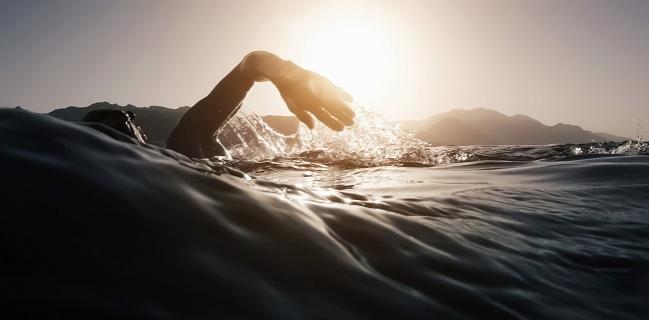No Gravity, Smaller Hearts: LV Mass Declines in Space and Water
Low-intensity exercise failed to counteract the cardiac effects of prolonged weightlessness in space or long-distance swimming.

American astronaut Scott Kelly, who spent 340 days aboard the International Space Station (ISS) in 2015-16, and endurance athlete Benoît Lecomte, who took 159 days to swim 2,821 kilometers across the Atlantic’s frigid waters in 2018, each lost as much as 25% of their heart’s mass despite the substantial amounts of exercise both did during their respective efforts, according to a new research letter published March 29, 2021, in Circulation.
James MacNamara, MD (UT Southwestern Medical Center, Dallas, TX), who led the study along with senior researcher Benjamin Levine, MD (UT Southwestern Medical Center), said they were surprised that Lecomte did not maintain his cardiac mass. Swim training for 1 to 3 hours per day at high intensity is associated with increases in left ventricular size and mass, but Lecomte swam at relatively low-to-moderate intensity for his extreme-endurance effort. Even Kelly, despite a regimented exercise plan, couldn’t offset the lack of gravity in space.
“A lot of low-intensity exercise, at least in these circumstances, was not enough to prevent loss of heart muscle mass,” said MacNamara.
Both extreme-duration spaceflight and extreme-duration swimming remove gravity from the equation, and despite being widely different endeavors, have similar consequences on the heart. “When we stand up, a lot of the fluid and blood in our body is pulled down by gravity, and what this does is it forces the heart to work harder to fight gravity,” MacNamara told TCTMD. “That work causes it to maintain its size and function. Going way back to the early space station studies, there’s been this question about what happens to the heart when you take away that gravitational effect.”
What was happening, he said, is that a lot of astronauts would return to earth and then faint when they tried to stand up. Orthostatic intolerance has also been observed among patients confined to bed for long periods of time.
With water immersion and supine bed rest, both of which serve as analogs for weightlessness, there is an initial increase in central blood volume caused by the reversed orthostatic gradients, explain the investigators. However, this is eventually reversed following diuresis brought on by atrial natriuretic peptide stimulation and antidiuretic hormone inhibition. In spaceflight, there is also a short-term rise in cardiac preload, followed by a decrease in blood volume and a long-term reduction in preload. Without counteracting that, extended spaceflight can lead to cardiac atrophy and orthostatic intolerance, say investigators.
Lots of Exercise, Smaller Hearts
In this study, investigators wanted to know if long-term weightlessness could be counteracted by exercise; both Scott Kelly and Benoît Lecomte gave permission to be identified by name in the paper. In 2018, Lecomte swam for an average of 5.8 hours per day (range 1.1 to 9 hours) for 159 days, with interruptions of 7 and 32 days because of bad weather. He slept for 8 hours per night and didn’t have a set hydration plan. In total, he spent anywhere from 9 to 17 hours in the prone or supine position. On the ISS, Kelly exercised 6 days per week and had the choice of cycling, use of a treadmill, or resistance exercise.
“What we found, quite to our surprise, is that the hearts did get smaller at a remarkably similar rate,” said MacNamara. “When we look at the mass, both Mr. Lecomte and Captain Kelly lost about 20% to 25% of their heart mass at about the same rate of 0.7 grams per week.” That rate of LV mass loss isn’t a lot over a short period of time, he said, but given the amount of time in space and swimming, it added up to a significant loss. LV ejection fraction and markers of diastolic function did not consistently change in Kelly or Lecomte during their campaigns.
One major question emerging from this study is whether high-intensity exercise, such as interval training, would have offset the long-term exposure to weightlessness. If Kelly had done less exercise but with greater intensity, asked MacNamara, would it have offset the cardiac adaptations produced during prolonged spaceflight? Bed rest studies, he said, have suggested that higher-intensity exercises could prevent cardiac atrophy, but those studies were short in duration and it’s not known if the same could be achieved in space.
While this study of an astronaut and long-distance swimmer might not appear to have clinical implications, MacNamara said there are a number of patients with severe injuries confined to bed for long periods of time. “They’re also experiencing that loss of a gravitational gradient and this highlights the importance of working with them, especially those patients who might not be able to do high-intensity exercise,” he said. “It’s an illustration of what can happen to their hearts.”
Michael O’Riordan is the Managing Editor for TCTMD. He completed his undergraduate degrees at Queen’s University in Kingston, ON, and…
Read Full BioSources
MacNamara JP, Dias KA, Sarma S, et al. Cardiac effects of repeated weightlessness during extreme duration swimming compared with spaceflight. Circulation 2021;Epub ahead of print.
Disclosures
- Levine and MacNamara report no conflicts of interest.





Comments